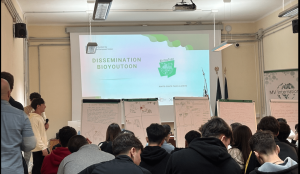Carolina M. Ahlstrand is an accomplished international business leader and passionate advocate for the global hydrogen economy. With a career spanning diverse industries and continents, she has built a reputation for driving strategic growth and forging impactful partnerships that accelerate the clean energy transition. From her early work in solids control operations on rigs to her transformative roles in tourism, oil and gas, and now clean tech, Carolina has consistently combined market intelligence, innovation, and stakeholder collaboration to deliver measurable results. In her current role at Hycamite, she focuses on advancing sustainable hydrogen and solid carbon solutions to decarbonize hard-to-abate industries—while championing greater representation and collective action in clean technology. Carolina’s leadership reflects her belief that climate progress demands clear vision, adaptable strategy, and a commitment to turning ideas into action at a global scale.

The Social Digest: Carolina, your profile showcases a fascinating journey, from diverse industries to your current impactful role at Hycamite. Could you briefly share what sparked your passion for the clean energy sector and what key experiences along the way have shaped your current focus on driving growth for sustainable hydrogen and carbon solutions?
Absolutely. My passion for clean energy actually began in childhood, sparked not by a classroom, but by a television campaign. I still remember those public service announcements urging families to “turn off the lights, save energy, and protect the planet.” They made a deep impression on me and planted the seed of responsibility toward our environment.
I began with solids control operations for onshore and offshore rigs. It wasn’t glamorous, but it was foundational and formative. That experience gave me a front-row seat to the scale and complexity of industrial emissions. I saw firsthand the urgency of transforming heavy industry to meet global climate goals.
Later, after relocating to Finland, I found myself at a unique inflection point. The global push for clean industrial innovation was accelerating—and in the U.S., the Inflation Reduction Act had just launched a wave of investment and ambition for decarbonization. That convergence felt like a calling. When I interviewed with Hycamite, I was already deeply drawn to the company’s mission and breakthrough methane-splitting technology. But realizing that two of the company’s founders were women made me feel like I was stepping into something even more powerful. Representation matters—and that moment reminded me that we’re not just transforming industry, we’re redefining who leads it.
Joining Hycamite allowed me to bring together my international business experience, my belief in sustainability, and a long-standing commitment to impact. At the heart of it all is STEM. It’s what empowers women to turn vision into action, and ideas into solutions. Because when women lead in science, technology, and business—we don’t just shape industries, we shape the future.
The Social Digest: You’ve developed and implemented business development strategies. Describe a successful strategy you led, including the key objectives, the steps you took, and the measurable outcomes. What were the biggest challenges you faced, and how did you overcome them?
I’ve been fortunate to work across very different sectors, but in both cases, strategy came down to the same core principle: deeply understanding your market and building bridges that didn’t exist before.
One of the most defining experiences came in Villahermosa, Tabasco, in the energy sector. I spearheaded the implementation of sales and operations strategies for a company providing solids control equipment to both offshore and onshore rigs in the Gulf of Mexico, as well as to mining companies in Northern Mexico. Until then, we operated reactively with no local inventory – delays were frequent and costly.
I led a strategy that focused on: Stocking critical equipment locally for the first time. Streamlining procurement through international trade optimization. Pricing competitively to meet both technical and financial expectations
The result? We tripled sales in under two years, improved delivery times significantly, and became the go-to provider for critical rig equipment. My background in international markets and trade regulations made it possible to scale efficiently while keeping costs under control.
The biggest challenges in both cases were internal alignment and industry-specific complexity. Whether it was navigating large corporate structures in tourism or the regulatory layers in energy, success depended on building trust—within the team, across departments, and with external partners. Clear communication and empathy were as vital as market insight and strategy.
Additionally, my experience in Houston, Texas, brought another dimension to my business development approach, this time within the highly competitive oil and gas and industrial sectors. There, I led a strategy to expand our client base by identifying emerging opportunities and marketing them, a rapidly evolving market segment with complex stakeholder ecosystems. The key objectives were to build credibility and scalability in a market dominated by established players and to accelerate lead generation for innovative solutions. I initiated a multi-pronged approach that included: 1. Hosting targeted workshops to educate potential clients on the benefits and feasibility of our technologies, 2. Developing strategic partnerships to co-create pilot projects, 3. Leveraging Houston’s dense network of industry events and trade shows to establish a visible and trusted presence, which included the Offshore Technology Conference (OTC).
This approach yielded measurable outcomes. The biggest challenges were breaking through the scepticism towards new technologies and navigating the entrenched supply chains. I overcame these by combining technical education with persistent relationship-building, tailoring communications to both technical experts and business decision-makers, and demonstrating quick, tangible pilot successes that built confidence. This Houston experience reinforced that adaptability and listening are critical, especially when introducing innovation into traditional markets.
And lastly, in my early beginnings, one of the most defining experiences was at Grupo Xcaret in Quintana Roo, Mexico, where I led the transformation of a small department into a major driver of visitor volume. At the time, we were welcoming just a few thousand guests annually through niche groups. I saw an untapped opportunity in pharmaceutical incentive travel from the U.S., and designed a tailored business development strategy that involved: 1. Creating targeted travel packages that matched the compliance, budget, and incentive structures of pharma clients, 2. Forging strategic alliances with local DMCs (Destination Management Companies), 3. Collaborating across departments to partner with airlines and hotels, creating seamless experiences.
This strategic pivot led to exponential growth in our group segment, inspiring the company to invest in building a new convention center to meet rising demand. It was a moment where data, relationships , and creativity aligned, and we scaled sustainably by listening carefully to what our clients needed before they asked for it.
The Social Digest: How do you approach developing strategic plans that align with both the immediate industry demands and the long-term vision for sustainable hydrogen and carbon solutions? can you help me with an answer and maybe an example of someone who is a leader in the field?
My approach to developing strategic plans that align immediate industry demands with the long-term vision for sustainable hydrogen and carbon solutions is grounded in three core principles: market intelligence, flexible innovation, and stakeholder collaboration.
First, I prioritize a deep understanding of the current market landscape—recognizing pressing needs such as cost reduction, regulatory compliance, and infrastructure readiness—while continuously scanning for emerging trends and technology advancements. This dual focus ensures that strategic initiatives address real, immediate challenges without losing sight of broader sustainability goals.
In addition, I emphasize flexibility in innovation. Given the rapid evolution of clean energy technologies, it’s crucial to develop scalable solutions that can adapt as new opportunities or constraints arise. This means structuring projects with modularity and phased implementation, allowing for course corrections and integration of breakthroughs over time.
Third, I foster close collaboration across diverse stakeholders—industry partners, government bodies, research institutions, and customers—to co-create strategies that balance commercial viability with environmental impact. Transparent communication and aligning incentives help build trust and ensure that the plan has broad support for long-term success.
Finally, I am inspired by many leaders in the field, leaders who balance vision with action, especially in spaces where innovation meets real-world impact. One such figure is Mexico’s President Claudia Sheinbaum, whose scientific background and environmental leadership are shaping Mexico’s approach to clean energy, infrastructure, and resilience. Her commitment to evidence-based policy and sustainable growth is a powerful example of how technical expertise and public service can meaningfully converge.
Closer to my daily work, I have the privilege of collaborating with women whose leadership actively shapes the clean tech landscape. Our CEO, Laura Rahikka, brings sharp strategic insight and unshakable purpose to the fast-paced environment of a clean hydrogen and carbon startup. She has guided our company through complex technical milestones, international expansion, and team growth—all while remaining grounded in our mission to accelerate decarbonization.
As Head of Carbon, Niina Grönqvist leads a pillar of our innovation: solid carbon production as a scalable tool for climate impact and energy security. Her work sits at the intersection of scientific rigor, industrial relevance, and environmental responsibility—making her a role model not only for the field but for how complex innovation should be led.
And from the policy and advocacy side, Roxana Bekmohammedi, founder and Executive Director of the U.S. Hydrogen Alliance, has been instrumental in shaping a favorable environment for clean hydrogen adoption in the United States. Her tireless work across agencies, companies, and coalitions ensures that momentum around hydrogen translates into meaningful, long-term progress. Her role as both founder and connector within USHA shows how leadership can amplify the voices of an entire emerging industry.
Working alongside and in partnership with leaders like Laura, Niina, and Roxana reminds me that in clean tech, progress is a collective achievement. In a startup, every day is fast-moving, decisions carry real impact, and leadership shows not just in what you deliver, but how you inspire others to keep building the future—together.
The Social Digest: As a “passionate advocate for the global hydrogen economy,” what do you see as the biggest hurdles and the most promising opportunities for the widespread adoption of low-carbon hydrogen and solid carbon products?
I see the biggest hurdles to widespread adoption rooted in regulatory uncertainty and fragmented policy frameworks. While public support for low-carbon hydrogen has grown significantly, the lack of clear, consistent, and future-oriented regulation across regions continues to delay Final Investment Decisions (FIDs). In some cases, regulations are too rigid or slow to adapt to emerging technologies—creating compliance bottlenecks rather than enabling market entry. This uncertainty affects everything from infrastructure planning and permitting to offtake agreements and cross-border trade, making it difficult for both investors and developers to move with confidence and speed.
On the other hand, the opportunities in this space are immense—and non-negotiable. The energy transition is not a matter of if, but how fast and how intelligently we can move. Low-carbon hydrogen and solid carbon products have a critical role to play in decarbonizing hard-to-abate sectors such as steel, chemicals, maritime transport, and heavy-duty logistics. Solid carbon, in particular, offers unique potential as a sustainable alternative to imported graphite or carbon black in battery production, construction materials, and advanced manufacturing—strengthening regional supply chains and improving resource security.
What gives me optimism is the growing alignment between industry and policy in recognizing that climate goals must go hand-in-hand with economic resilience. The most promising projects today are those that integrate multiple value streams—hydrogen, carbon, circularity, and local development—and are designed to scale with evolving regulation. Unlocking this future requires not just innovation, but trust-building across governments, investors, and communities.
The Social Digest: The clean tech space is rapidly evolving. What trends or innovations are you most excited about in 2025 and beyond, especially in hydrogen and carbon utilization?
The clean tech space is moving faster than ever—and what excites me most is the convergence of technological maturity with industrial urgency. In hydrogen, 2025 marks a clear shift from pilot projects to real-world implementation. We’re seeing the emergence of integrated hydrogen hubs, not just as isolated facilities, but as parts of broader ecosystems where production, offtake, logistics, and policy align to accelerate deployment.
I’m particularly energized by innovations in low-carbon hydrogen pathways beyond electrolysis—such as methane pyrolysis, which can produce clean hydrogen while capturing solid carbon as a valuable co-product. These solutions offer a realistic, near-term route to scale, especially in regions with access to existing natural gas infrastructure but limited renewable capacity.
On the carbon side, we’re entering a new phase of carbon valorization. What was once considered waste is now a feedstock for advanced materials, energy storage, and even circular construction. The use of solid carbon as a sustainable alternative to imported graphite or carbon black is gaining traction—not only for battery and composite materials, but also for building local, secure supply chains in strategic industries.
What makes this moment especially exciting is the momentum behind cross-sector collaboration—where clean tech innovators, heavy industry , and regulators are finally speaking the same language. The challenge now is to match that momentum with infrastructure, permitting agility, and financing mechanisms that are as innovative as the technology itself.
In short, I’m excited by the shift from “proof-of-concept” to “proof-of-impact”—where hydrogen and carbon technologies are no longer theoretical, but core to competitive, resilient, and climate-smart industrial strategies.
The Social Digest: Your work at Hycamite focuses on “decarbonizing industries.” Can you elaborate on specific industries you see as key targets for Hycamite’s technology and why? What are the unique challenges and opportunities within these sectors?
When we talk about decarbonizing industries, the general focus naturally gravitates toward sectors that are both emissions-intensive and hard to abate—where electrification alone isn’t a viable solution in the near term. Among these, steel manufacturing, chemical production, and refining stand out as key targets for low-carbon hydrogen and carbon-based clean technologies.
Steelmaking, for example, is undergoing a major transformation. Traditional blast furnace routes are increasingly being replaced or supplemented by direct reduced iron (DRI) processes that can operate with hydrogen instead of coal. This not only reduces emissions dramatically but also repositions hydrogen as a structural component of future materials production. Europe, Japan and parts of the U.S. are already investing heavily in these conversions.
Similarly, in ammonia, methanol, and refining, hydrogen is a critical feedstock—often produced today through high-emission Steam Methane Reforming (SMR). Replacing or complementing SMR with low-carbon hydrogen alternatives offers a fast, scalable path to reducing the carbon intensity of these products without overhauling entire systems. These sectors also tend to have the infrastructure, offtake certainty , and policy attention that enable early adoption.
On the carbon side, solid carbon by-products can play a meaningful role in battery manufacturing, construction materials, and filtration media, offering sustainable, domestically sourced alternatives to imported critical materials like graphite or carbon black.
The opportunities in these industries are substantial, —but so are the challenges. These include long asset lifecycles, complex permitting, and the need for strong policy alignment to de-risk early investment. However, the momentum is real, and with the right combination of innovation, public-private cooperation and market design, these sectors can lead the next wave of industrial decarbonization.
The Social Digest: You’ve held leadership roles across diverse industries. What are some key leadership principles that you’ve found to be universally effective, regardless of the sector?
Across every industry I’ve worked in—tourism, energy, technology, and cleantech—the most enduring leadership principles have always centered on clarity, empathy, and adaptability. But in today’s landscape, especially with AI reshaping how we work and make decisions, these qualities are not just nice to have—they’re foundational.
One principle that’s universally effective is the ability to create clarity in complexity. Whether leading through regulatory shifts in energy or fast-paced digital transformation, people look to leaders who can synthesize vast, sometimes contradictory information into clear direction. With AI now accelerating the speed and scale of data generation, that clarity is more important—and more challenging—than ever.
The second is empathy-driven leadership. As AI and automation redefine roles and skill sets, the human side of leadership matters more. Supporting teams through uncertainty, championing continuous learning, and creating environments where diverse thinking thrives is critical in sectors that are being restructured in real time.
Third, the principle of adaptability has taken on new urgency. In the past, experience and industry knowledge were guiding anchors. Now, many of the “knowns” are being reinvented. Leadership today means being comfortable with evolving truths, willing to unlearn, and open to co-creating solutions with teams, technology—and sometimes, algorithms.
At the end of the day, good leadership is not about knowing everything. It’s about staying grounded in purpose, curious in practice , and agile enough to lead through change—especially when the change is exponential.
The Social Digest: You’ve “spearheaded partnerships, alliances, sales, and marketing initiatives.” Tell us about a significant partnership or alliance you built. What were the keys to its success, and how did you navigate any potential challenges?
A recent example of a strategic alliance I helped initiate was our decision to join the United States Hydrogen Alliance. While I didn’t create the alliance, I recognized its unique potential to support our goals at a critical time in our U.S. expansion. It stood out among several options due to its strong advocacy platform and its ability to unite diverse members—from infrastructure developers to technology providers—around shared policy objectives.
As the main point of contact for our company, I actively engage with alliances and similar organizations such as CHARGE, JCDREAM, the Pacific Northwest Hydrogen and Renewable Alliance, and NAATBatt (for graphite and battery materials). These partnerships have been instrumental in amplifying our voice in policy discussions, staying ahead of regulatory developments, and fostering pre-commercial collaboration across the hydrogen and advanced materials value chains.
The key to navigating these relationships is understanding how each organization contributes uniquely to the ecosystem, maintaining open lines of communication, and ensuring we are aligned with both short-term opportunities and long-term policy frameworks. Being part of these alliances has helped us stay strategically positioned as the clean tech landscape evolves across multiple fronts.
Similar efforts are done with other associations in Canada and Europe to name a few.
And new partnerships are taking shape as we speak. But your readers will have to wait a little longer to hear what’s next. Stay tuned.
The Social Digest: Your work goes beyond business, touching on energy security, climate impact, and policy. How do you stay informed and strategically agile in such a fast-changing ecosystem?
The networks previously mentioned , provide not only early insight into policy and market trends, but also a platform for real-time dialogue with stakeholders across the value chain.
Beyond that, I stay curious and connected across disciplines—tracking developments in permitting reform, grid infrastructure, funding mechanisms and international hydrogen diplomacy. It’s the only way to remain agile when regulation, innovation, and geopolitics shift simultaneously. I also work with a tremendous team and we all stay informed on the latest trends, technologies and developments.
And if there’s a webinar or panel discussion happening—chances are, you’ll see me there! Staying current often means working across time zones, tuning in at odd hours, and continuously learning from peers across the globe. In this ecosystem, adaptability comes not just from knowing what’s next—but from being part of the conversation as it unfolds.
The Social Digest: Lastly, how can global citizens—whether in tech, finance, or the arts— contribute meaningfully to the clean energy transition, even if they’re not in the energy industry?
As someone who grew up in one of the largest cities in the world and has since lived across continents – learning new languages, adapting to new systems, and building a multicultural life and career—being a global citizen is more than an identity; it’s a mindset. Today, my colleagues come from different corners of the world, and my family reflects that same international tapestry. That perspective shapes how I see the clean energy transition: not as a niche sector challenge, but as a global responsibility.
You don’t have to work in energy to make a meaningful impact. We all influence the systems around us through how we invest, design, advocate, consume, and lead. The transition needs every skill set, every voice, and every perspective.
For women especially, bringing diverse experiences to the forefront—whether as professionals, mothers, creatives, or entrepreneurs – is not just empowering, it’s transformational. We are not only navigating change; we are building the bridge to what comes next. And it’s through collaboration across sectors, cultures, and disciplines that this transition becomes not just possible, but inevitable.
This interview was conducted by our Head of outreach, Ansh Vachhani, The Social Digest on 21/05/2025. If you have any interview recommendations or have a story that you want to share with our readers, get in touch with our editor Vedant Bhrambhatt, at editor@thesocialdigest.com



